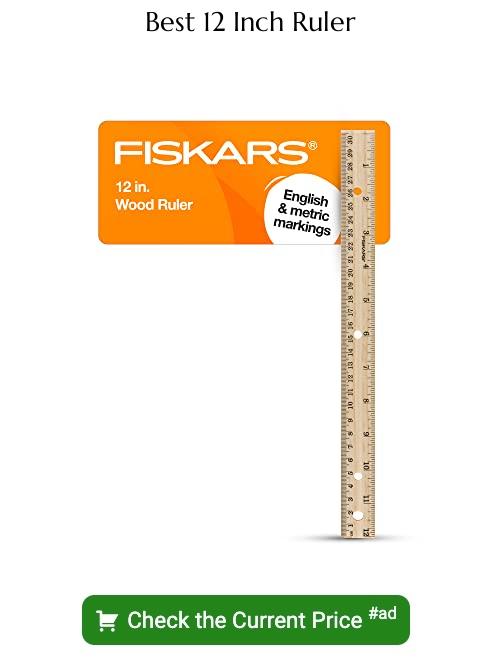Last updated on
Diving straight into the heart of measurements, this exploration discusses the omnipresent 12-inch standard, drawing comparisons to better visualize its applicability in real-life scenarios.
Key takeaways:
- Twelve inches is equivalent to one foot in the Imperial system.
- In the metric system, twelve inches is approximately 30.48 centimeters or 304.8 millimeters.
- A 12-inch length in high-quality printing translates to 3,600 dots (or pixels) in a line.
- Everyday items that are typically 12 inches long include standard rulers, hardcover books, and large loaves of bread.
- In various fields and contexts, twelve inches is used to determine dimensions, spacing, and proportions, such as in home improvement, screen sizes, sports, culinary measurements, transportation, and furniture design.
What's Inside
Understanding 12 Inches in Different Units of Measurement

Diving straight into it, twelve inches equates to one foot, a standard unit in the Imperial system. To visualize in metric terms, that’s approximately 30.48 centimeters. If you’re more comfortable with millimeters, picture 304.8 of them end-to-end. For those who think in meters, you’re looking at 0.3048 meters – more than a quarter but less than a third. This conversion to metric allows for easier interdisciplinary usage, striking a bridge between systems favored in different regions or fields.
In contrast, if you prefer a nautical theme, 12 inches is just a tad under a third of a fathom, the unit typically used to measure water depth.
When we move into the digital realm, pixels can be a measure of length in design and digital imagery; however, the comparison with inches depends on the resolution of the display. For reference, printing at 300 dots per inch (DPI), which is considered high quality, a 12-inch length translates into 3,600 dots (or pixels) in a line.
Understanding these conversions is pivotal for fields requiring precise measurements and for everyday tasks, from selecting the correct screen size to ensuring that home decor fits your space.
Visual Comparison to Common Objects

To grasp the size of 12 inches, picture everyday items you might have around. A standard ruler or a subway sandwich offers a perfect real-world example.
If you enjoy reading, consider a hardcover book, which typically measures about 12 inches in height. In the tech realm, the screen of a small laptop or tablet might be about that length diagonally.
In the realm of personal accessories, an unfolded dollar bill is slightly over 6 inches long, so two placed end-to-end gives you a good approximation. Looking at a standard kitchen item, the width of a large loaf of bread is roughly 12 inches.
These comparisons offer tangible ways to visualize this measure without reaching for a tape measure.
The 12-Inch Foot in Historical Context
Delving into history, the foot as a unit of measurement has fascinating roots, tracing back to various systems where it was defined by the human anatomy. Primarily, it was the length of the king’s own foot which often set the standard for the realm, illustrating how anthropometric systems were central to early measurement practices.
The Roman foot, or “pes,” was one of the early instances of this, measuring roughly 11.65 inches. However, advancements in measurement standardization led to the ‘international foot,’ which was defined as 12 inches, cementing the foot’s place in modern measurement systems. This shift allowed for uniformity, particularly critical when it came to trade and construction, where precise, common standards were necessary for fair and consistent practices.
Furthermore, the foot has been split into 12 inches, believed to be inspired by the convenience of the duodecimal system—one readily divisible by 2, 3, 4, and 6—enhancing the foot’s applicability in a range of mathematical calculations and fields.
Recognizing these historical underpinnings not only adds depth to our understanding of measurement but also reveals the evolution of how we quantify the world around us. The inches that we rely on today are more than just units; they are echoes of a time when measures were deeply personal and varied from one leader to another—yet the foot has walked its way into standardization, illustrating our drive for order and consistency.
Practical Uses in Home Improvement and DIY Projects
When tackling home improvement and DIY projects, a 12-inch measurement frequently comes into play. This is a standard size for various materials and tools, which makes knowing how to measure it accurately quite important.
Shelving and Cabinetry: When creating custom shelving or cabinets, a depth of 12 inches is commonly used, as it allows for ample storage without protruding too much into the living space.
Framing: In construction, the spacing between wall studs is often 16 inches or 24 inches on center. However, for some interior non-load-bearing walls, a 12-inch spacing might be utilized. Understanding this measurement ensures proper alignment of drywall panels and fixtures.
Gardening: For raised garden beds, a depth of 12 inches is ideal for allowing a variety of plants to thrive, offering enough room for roots to spread out.
Flooring: Buying tile for a new floor? Tiles come in many sizes, but a 12-inch square is standard. It’s also a common measurement guide for laying planks or tiles to ensure consistent spacing and symmetry.
Crafting: For small woodworking or crafting, 12 inches is a basic dimension for table saws or crafting mats, aiding in creating perfectly sized components.
The Relevance of 12 Inches in Display Screen Sizes
When selecting a new device, screen size is paramount. A 12-inch display diagonally measures from one corner to the opposite. It’s larger than a typical tablet yet smaller than many laptops, striking a balance between portability and visibility.
This dimension is favored for its ability to comfortably house a standard keyboard when designing 2-in-1 tablets and laptops. Users can enjoy a full-size keyboard without the bulk, perfect for productivity on the go.
It’s important to note that a 12-inch screen on a tablet offers more viewing real estate due to minimal bezels compared to laptops with integrated keyboards and larger frames.
Image clarity is another consideration. At this size, a high resolution can provide stunning detail without straining battery life as larger screens might. Therefore, for avid readers, video streamers, or mobile gamers, the 12-inch display offers an appealing mix of size and efficiency.
Significance in Sports and Recreation
In the realm of sports and recreation, 12 inches play a pivotal role. Take basketball, for instance—the diameter of a standard hoop is 18 inches, only 6 inches more than our measurement of interest. This precision in size underlines the skill needed to successfully shoot a ball through the hoop from various distances.
When it comes to fishing, rods are often categorized by their length in feet, with 6-foot (72 inches) rods being common for beginners. This means that a 12-inch section is one-sixth of the rod, a useful increment for understanding its flexibility and handling characteristics.
In softball, the size of the ball used is approximately 12 inches in circumference, dictating the grip and pitching techniques players must master. This measurement sets the standard for the sport, influencing everything from the design of gloves to the rules of the game.
In the world of fitness, 12-inch step boxes are commonly used in aerobic and plyometric exercises, providing a moderate height for a range of workouts that improve balance, strength, and cardiorespiratory fitness.
Lastly, skateboard decks are typically around 32 inches long, with the width varying. A 12-inch width would be on the wider end, creating a more stable platform for tricks and cruising—vital for developing board control and confidence.
These examples illustrate how a seemingly simple measurement intertwines with the intricacies of sports and recreational activities. Understanding the dimensional footprint in each context helps to appreciate the design and rules that define these diverse and passionate pursuits.
Inches in Culinary Context: Pizza and Baking Sheets
A 12-inch measurement takes on delicious importance in the culinary world, especially when it involves pizzas and baking sheets. When you order a medium-sized pizza, what you’re really getting is typically a 12-inch diameter circle of mouth-watering goodness. This size easily serves 2-4 people, making it a go-to option for small gatherings.
In baking, a 12-inch dimension is often seen in the form of square or rectangular baking sheets. This size is versatile for home ovens, fitting comfortably while providing ample space for a dozen cookies or a sizable sheet cake. When recipes call for a ‘half sheet‘ pan, they’re referring to an 18×13-inch pan, so a 12-inch pan is a scaled-down version, perfect for more modest batches.
Remember, in the context of kitchenware, 12 inches typically refers to the product’s usable cooking area, not the total size including edges or handles, so always check your oven dimensions before purchasing new bakeware to ensure a perfect fit.
Transportation: Bike Frames and Car Rims
When it comes to transportation, 12 inches can play a pivotal role in both performance and aesthetics. In the world of cycling, children’s bike frames often start at this length, ideal for those just shedding their training wheels. This dimension provides the right balance between stability and manageability for the young rider.
On the road, car enthusiasts might talk about 12-inch rims, which are relatively small by modern standards but can still be found on classic cars or certain compact models. Smaller rims accommodate thicker tires which can result in a smoother ride over rough surfaces, showcasing the impact of this measurement on comfort and handling. Additionally, tire replacement costs for 12-inch rims are generally lower, an economic point worth noting.
Whether choosing the right bike for a child or maintaining a classic car, understanding how 12 inches affect both function and form is essential for making informed decisions about these modes of transport.
Architecture and Interior Design: Furniture Dimensions
In architecture and interior design, 12 inches, equivalent to one foot, serves as a fundamental unit for mapping out spaces. It is crucial in determining the dimensions of furniture and ensuring that pieces fit proportionally within a room.
- Ergonomics and Clearance: When planning for walkways or space between furniture, a minimum of 12 inches is often considered for clearances to provide comfortable passage.
- Modular Design: Many furniture systems are based on 12-inch increments, allowing for seamless integration and versatility within spaces that must be adaptable to various needs.
- Storage Solutions: Shelves and cabinets frequently exhibit a depth of 12 inches, optimizing storage while maintaining accessibility and aesthetic balance.
- Height Standardization: End tables and coffee tables typically stand around 12 inches tall, harmonizing with the standard seat heights of sofas and chairs to create cohesiveness in a living space.
By recognizing the significance of this measurement in design, you can create functional, comfortable, and visually pleasing environments.
FAQ
How long is 12 inches compared to an object?
Twelve inches, equivalent to one foot, is roughly the length of a standard-sized ruler, a common object used for measurements.
What is approximately 12 inches?
Approximately 12 inches is equivalent to one foot.
Are most feet 12 inches?
Yes, indeed, the standard measurement of a foot is equivalent to 12 inches.
Does 12 inches equal 1 foot?
Indeed, 12 inches are equivalent to 1 foot.
How does 12 inches relate to the size of standard American paper?
The length of a standard American letter paper is 11 inches, making it 1 inch shorter than 12 inches.
What everyday items are typically 12 inches long?
Standard rulers, some longboard skateboards, and small acoustic guitars are all examples of everyday items that are typically 12 inches long.
What is the significance of 12 inches in measurement standards such as the Imperial system?
In the Imperial system of measurement, 12 inches equates to 1 foot, establishing a fundamental standard for short-range distance measurements.





